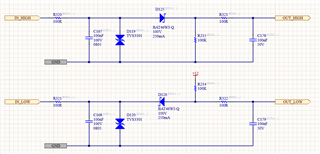Other Parts Discussed in Thread: TVS3301
Tool/software:
Hello,
I am considering using the TIC12400-Q1 MSDI device in a 24V system. I have reviewed the app note, but it seems to me adding the resistive divider stage will make it so that it is not possible to use the wetting current feature. Is that correct?
As an alternative, I was thinking I might be able to use the TVS3301 flat clamp device to protect the inputs (instead of the TVS + resistive divider stage). Is that a reasonable solution? I believe it will still require the Schottky diode in series to protect against negative voltage swings.

